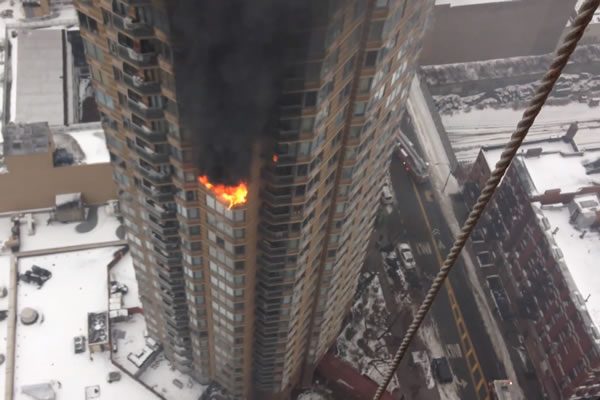Last month I wrote about a fatal fire in a Manhattan high-rise residential building, where non-compliant fire doors likely had an effect on the outcome. There was initially a lot of publicity surrounding this tragedy and even a proposal for new legislation, but as I feared, within a couple of weeks the media was no longer reporting on the story. I recently read the article below in the monthly newsletter from the Center for Campus Fire Safety, and I loved it so much that I asked them if I could share it with you. It gives a different perspective on the same issues that I preach about all the time, from Phil Chandler, a firefighter and fire marshal. Many thanks to the Center for Campus Fire Safety, and to Phil.
 .
.
The Inspector
by Phil Chandler, January 2014
“I hope no one has a fire—but if they do, I want to be there.”
Chief Nerney had a special way of sharing the soul of firefighting with new recruits right up to the time, some thirty odd years ago, when he gave up his own soul in a smoky alleyway. I only served under his command for one year before his untimely passing, but his battle scarred words inform my perceptions and actions to this day.
Whenever I hear of a fire, I want to be there. I want to see it, hear it and even taste it. I want to know how it started and how it was extinguished. If I can’t be there in person, I want to use every media device available to put me on the scene. To those outside of the fire service, my fascination with fire must surely seem bizarre, at best. I can offer little rational explanation why some of us are drawn to firefighting, what it is exactly that propels us into this unique avocation and profession. It cuts a lot deeper than simply “wanting to give something back.”
Even now, when I spend less time dragging hose and a whole lot more time inspecting buildings and filling out endless reports, I still am relentless in following up on every fire that appears on my horizon. If a fire can happen in one time and place, I assume it can happen in another. My job as a fire inspector is to convince others that just such an occurrence is as likely as not to happen in their building. Of course I run the risk of being forever cast as a doomsayer. Oh well, the truth is not always popular or pleasant.
 We on the east coast have recently become painfully aware of a fatal fire in a luxury high-rise building in Manhattan’s Hell’s Kitchen neighborhood. The fire was on the 20th floor. The deceased was found in the stairwell at the 31st floor. Right off the bat, there’s something really wrong with this picture. How does one succumb to a fire eleven stories below in a modern (though not sprinklered) noncombustible building?
We on the east coast have recently become painfully aware of a fatal fire in a luxury high-rise building in Manhattan’s Hell’s Kitchen neighborhood. The fire was on the 20th floor. The deceased was found in the stairwell at the 31st floor. Right off the bat, there’s something really wrong with this picture. How does one succumb to a fire eleven stories below in a modern (though not sprinklered) noncombustible building?
All fire fatalities are, of course, preventable, but this loss, more than others, seems totally avoidable. Its senselessness makes it all the more painful to contemplate. Yet we cannot turn our backs on this tragedy, chalking it up to bad karma or a misalignment of the stars. It was the result of uninformed actions driven by the unpredictable vagaries of human nature. As such, this fire could just as easily happen in your neighborhood, on your campus, at any time.
The particulars are actually quite unremarkable. The fire was caused by an overloaded multi-tap extension cord. When the fire was discovered, the occupant did what most folks might do: flee. Yet unfortunately he neglected the most cardinal rule of fire safety, one widely featured in in all FDNY tenant training: Close the door! Lacking a working door-closer, the growing fire was given all the air it needed to grow unchecked, extending its reach into the hallway, pumping black smoke into the stairwells.
While limited reports so far available have not indicated the status of the doors to the stairwells, our experience on countless campus buildings suggests that one or more of the doors may have been chocked open or as is often the case, failed to close and latch, thus allowing smoke entry under the pressure of a rapidly expanding inferno.
Against this backdrop are the actions of the deceased and his spouse. They too, when learning of the raging fire below, also did what most others would do: evacuate. After all, isn’t that what we encourage everyone to do in our residence halls: Stay low and go? Fleeing danger is intuitive. Sheltering in place must be taught and reinforced. Regrettably, this lesson was not learned, or perhaps in the post-9/11 environment, it has lost credibility. Regardless, the outcome was tragic.
The Inspector, and I guess many of you as well, resolve to start the new year with rededication to our life-saving mission. I force myself to take a hard look at the out-going year, to see what I might have done better. I also look to improve and strengthen my efforts for the upcoming year.
The aforementioned fire on West 43rd Street will for me be a perfect touchstone with which to set my direction and I hope for you as well. We can all resolve to fight off complacency when encountering all of those garden-variety violations that seem to never go away, such as the chocking of fire doors. It is easy to succumb to the relentless objections heaped on us for removing the wedges and gadgets used to keep these doors from closing. We must persevere. Close it or install an approved hold-open device! As innocuous a violation as this may be, the evidence is in. An open fire door may prove fatal. It matters not if the fire is on the 2nd floor or the 20th. Smoke entering a vertical exit enclosure is a killer.
Similarly, we must redouble our efforts in implementing a robust opening protective inspection and maintenance program as outlined by NFPA 80. Keeping all of our passive protective devices functioning as intended is an essential component of life safety. A fire door that fails to close securely is of little help in holding back the wrath of a freeburning fire. A door maintenance program is costly, but the alternatives are more so. The potential loss of life is the most extreme consequence, but even the expense of repainting a building is significant.
And last, but not least, is our constant need to counter the frequently illogical actions of building occupants. We are all human. Give any of us a lung full of acrid smoke and we may all act irrationally. Which means one thing: we must never relax our commitment to giving all building occupants ongoing life safety training, especially evacuation training. Simply pulling the fire hook and watching from across the street doesn’t cut it. We need realistic training tailored to the particular needs of very building and we need to deliver it face to face. We need to address all of the what-ifs that occupants may propose. And most importantly, we must believe our own rhetoric.
If we hope to enlist the assistance of the general public in assuring its own safety in the event of fire, we ourselves must truly believe that the fire next time is minutes away from occurring in our own building and train accordingly. Best wishes for a safe and productive new year.
Philip Chandler is a long time firefighter and a fulltime government fire marshal working extensively in the college environment – from large public university centers to small private colleges. His primary responsibilities include code enforcement and education. Phil welcomes your comments, thoughts and opinions (whether in agreement or opposition) to his viewpoints. He may be reached at: theinspector@campusfiresafety.org
Ask the Inspector – Now Members can log onto the Member Website and have an online discussion with “The Inspector”. Simply visit the MEMBER LOGIN section of our public website. Once logged in, look for the Town Hall Discussions and ask “The Inspector”.
Note: The viewpoints expressed in The Inspector are those of the author alone. They are offered to initiate thought and debate, however, they do not necessarily represent the views or opinions of The Center for Campus Fire Safety, its officers, directors or its editorial staff.
Published by The Center for Campus Fire Safety, www.campusfiresafety.org, 978.961.0410.
Image: WashingtonBlade
You need to login or register to bookmark/favorite this content.





When Phil says “I want to see it, hear it and even taste it.”, most people don’t understand, but I do. My father was a career firefighter who worked days and went to school at night in order to work his way up the ladder, no pun intended. And up he went, all the way to Chief. Many years ago, after he had been retired for a year or two, I had a clothes dryer fire in the basement of my house. No serious damage, other than a few charred floor joists overhead and our clothes that were in the dryer, but still the house reeked of burned wood and smoke. My father came by to survey the damage. Down in the basement he took a deep breath in through his nose, turned to me and said “Forgive me for saying this, but I love that smell.”
And every firefighter I know is the same way. They don’t want anyone to go through the loss and hardship that fires inevitably bring, but if there’s going to be a fire somewhere, they want to be there.
Thank you for sharing that story, Chuck!
Phil,
Though I appreciated reading the article it seems that the very first statement is inaccurate (unfortunately damaging as well when the media gets involved). The doors themselves by no means could be non-compliant in this instance. If the door closers themselves were malfunctioning, or the door itself was chocked open, then in that case the non-compliance falls on building management or hired entities that are paid to maintain the fire rated hardware that is applied to the door opening as well as the monitoring for violation of any fire code such as chocking a stairwell door open (which is a HUGE no-no in any multilevel building). All fire doors can only be installed, inspected/approved, and operate to their full capacity when the installation is made with the approved hardware (door closers, smoke seals, fire tags etc). Improper use (such as propping a stairwell door open) is a violation of all fire codes across the entire country and is normally monitored or electronically controlled with fire prevention systems. I could only compare this to a tornado door that is chocked open during a twister, in which case the door would not be to blame for any injuries and/or deaths resulting from such. My only reason for pointing these things out are so the correct areas are pursued to prevent such a tragedy from happening again. I speak of this only from my experience in the fire door and hardware industry. Thank you for sharing and it is my hope that you continue your pursuit of this and help in the prevention of any future senseless deaths in a situation like this one.
Thank you,
Toby